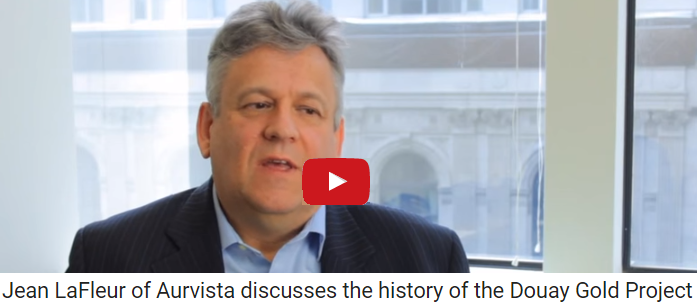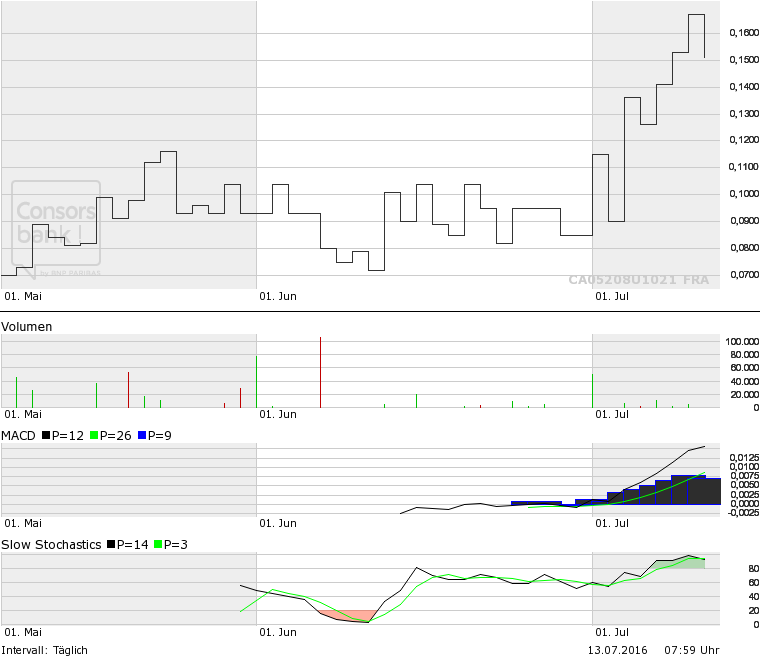 In late June, Aurvista Gold Corp. started its summer exploration program at its fully owned Douay Gold Project in the prolific Abitibi Greenstone Belt of northern Québec. The 2-staged program is expected to be completed in September and as such an increased newsflow is anticipated over the summer. Phase-1 will involve airborne geophysics to define key contacts, faults and porphyry up to a depth of 150 m (these features are typically linked to the massive sulphide lenses within a 6 x 1 km gold-copper corridor). Phase-2 will consist of 4,000 m of drilling to delineate additional gold and/or copper-gold mineralization on the best targets identified in phase-1. Over the last years, only very little exploration has been done on the camp-scale property (145 km2 or 20 km strike length of a fault, the Casa Berardi Break south of and parallel to the Detour Trend). Within a 5 km window, 3 million oz of gold have been discovered to date. Thus, 15 of the 20 km prospective trend remains completely unexplored. Groups like Thomas Kaplan’s Electrum used to only pursue opportunities in gold with a minimum of 5 million oz in North America. However, there are not many of such elephant-sized gold deposits left. The upcoming drill program has been designed to find additional resources in order to get closer to this “magic” 5 million oz level.
In late June, Aurvista Gold Corp. started its summer exploration program at its fully owned Douay Gold Project in the prolific Abitibi Greenstone Belt of northern Québec. The 2-staged program is expected to be completed in September and as such an increased newsflow is anticipated over the summer. Phase-1 will involve airborne geophysics to define key contacts, faults and porphyry up to a depth of 150 m (these features are typically linked to the massive sulphide lenses within a 6 x 1 km gold-copper corridor). Phase-2 will consist of 4,000 m of drilling to delineate additional gold and/or copper-gold mineralization on the best targets identified in phase-1. Over the last years, only very little exploration has been done on the camp-scale property (145 km2 or 20 km strike length of a fault, the Casa Berardi Break south of and parallel to the Detour Trend). Within a 5 km window, 3 million oz of gold have been discovered to date. Thus, 15 of the 20 km prospective trend remains completely unexplored. Groups like Thomas Kaplan’s Electrum used to only pursue opportunities in gold with a minimum of 5 million oz in North America. However, there are not many of such elephant-sized gold deposits left. The upcoming drill program has been designed to find additional resources in order to get closer to this “magic” 5 million oz level.
The Douay Deposit is opined to be among the very few remaining (known) gold deposit in Québec amenable for a superpit, i.e. bulk tonnage, low-grade ore with high-grade lenses. Before, there were
Dome, Kerr, Macassa, Teck-Hughes, McIntyre and
Hollinger (together 100 million oz gold),
Detour (20 million oz),
Malartic (15 million oz) and
Sigma-Lamaque (12 million oz).
In the initiating coverage
“An Intact Jewel Box for Golds New Bull Market” (May 18,2016), Douay was compared to the
(Canadian) Malartic Deposit as both share similar regional and local settings (same Abitibi Gold Belt). Structural patterns at Douay are comparable with Malartic at 100 km, 1 km and 1 cm scales:


Certainly, Douay is an earlier exploration stage project than Malartic was in 2004 when Osisko acquired the project and developed it into Canada’s largest gold mine in less than 7 years.However, Douay has a major strategic advantage:
The higher grade gold lenses are still present at Douay.
Production at the Malartic Mine began in 1935 and continued uninterrupted until 1965. Malartic was mined mostly by underground long-hole stoping methods, making it the only underground bulk tonnage gold mine in Quebec at that time. Mining was only focused on the higher grade (+3 g/t) gold zones and produced a total of 1.1 million oz.
By the time Osisko acquired the Canadian Malartic Mine in 2004, all of the high-grade lenses had been mined out.
So what we have with Douay now is a Malartic analog, but with significant sweeteners: The high-grade lenses. Imagine a chocolate chip muffin that someone managed to eat only the chocolate chips – that’s Malartic (in 2004). Aurvista owns an intact muffin with all of the chocolate chips still present.
When Osisko acquired Malartic in 2004 and developed it into an economic mine until 2011 (proven and probable reserves of nearly 11 million oz averaging 0.97 g/t gold with a 0.3-0.32 g/t cut-off), a strong bull market in gold took place. Unfortunately once production started, the gold price began a 5 year bear market. Yet these circumstances allowed Osisko to prove the case that bulk tonnage, low-grade gold deposits can be developed into highly economic mines in bull markets, and that senior mining companies will fight tooth and nail even in times like 2014, when the bear market in gold was culminating, to get their hands on such a big and profitable mine.
Douay’s “jewel box”, as Jean Lafleur of Aurvista likes to call it, is still intact as no historic mining has cherry-picked the high-grade portions, making it a pristine grassroot gold project (in contrast to a brownfield project like Malartic in 2004) with large advanced exploration areas.
During gold’s last bull phase (2000-2011), the market focussed on the few remaining high-grade deposits, such as Goldquest and its Dominican project, whereas Osisko’s Malartic Project was a somewhat standalone exception. Over the last 5 years, the tide has turned to safe mining jurisdictions and Malartic has demonstrated that bulk tonnage, low-grade gold deposits can make fortunes even in times of depressed gold prices (
2015 total cash costs:
$596 USD/oz plus $23 CAD/t mine-site costs incl. royalties).
The Douay Project is 25% an advanced exploration project and 75% grassroots. Virtually all the majors have toured the property in the past and none have said anything negative, according to a statement from Aurvista. They have all said that, despite the 3 million oz gold, more work on the grassroots portion is required. However, grassroots exploration has been tough to finance in the last 5 years as the “normal” junior model of drilling and issueing drill results to then raise money has been broken. Osisko used this model to great success and a new bull market in gold is likely to change this picture again, especially when considering that Douay is one of the few large gold deposits left in a safe and established mining jurisdiction.
While it would only take 2-3 years to get the
Douay West Zone into production, the upcoming drill program may delineate +5 million oz in the currently known target areas.
Why?
1)Just like Dome, Malartic and the Abitibi generally: If you drill more, you get more;
2) Nugget effect of high-grade veins, pods and lenses in a porphyry deposit like Douay;
3) Current resource still mostly based at 200 m drill spacing and large spacing could add oz significantly;
4) Minimal drilling to date in some of the high potential zones like
NW, Main and
Adams. Therefore, +5 million oz from existing zones is considered a somewhat reasonable expectation. Another 5 million oz could be identified on other nearby targets that remain untested to date.

 Douay West
Douay West and
Adams are available to go into production already now as having resources for 10+ years at 35,000 oz/year (PEA stated 45,000 oz/year). The December 2014 PEA has focussed on
underground mining showing total CAPEX of $57 million. Aurvista could go solo, like Osisko did (taken out in the 4th year of commercial production), however Aurvista currently thinks that it’s best to find a (financial) partner. Yet, if the gold bull returns, Aurvista may be lifted into a position to become the next Osisko and put Douay into production by itself.
Aurvista plans to find the start of an additional 5 million oz, as then they would have the potential for a 10 million oz gold deposit, which is a completely different ball park than the current 3 million oz. Rockstone believes that Douay is one of the most undervalued undeveloped large gold assets left in North America and primed to be put in production next, especially with higher gold prices.




According to Aurvista’s news
“Aurvista Plans Significant Exploration Program at Douay” (June 14, 2016):
The first stage work will complete the Priority Targeting Program in two areas where management is confident additional gold mineralization will be uncovered. The areas include the:
(1) 10 x 3 km wide (at its longest and widest points) SE-tilted parallelogram-shaped Douay-Style Mineralization (“DSM”) containing all the known gold zones (
Douay West, 10, 20, 531, Central, Main, NW, Porphyry and the
South Porphyry) and current Mineral Resource estimates; and the
(2) 6 x 1 km wide cluster of EM INPUTTM anomalies or conduit ctors running along the southeast boundary of the DSM that have affinities to Volcanogenic Massive Sulphide or VMS mineralization associated with gold.
The second stage will consist of a 4,000 meters of drilling to delineate additional gold and/or coppergold mineralization on the best targets.
Priority Targeting Program
Now with funding in place, the company intends on completing the Priority Targeting Program. This will involve:
- Completing an airborne geophysical Magnetic, Electromagnetic and Radiometric survey of the central portion of the Douay Project to define key contacts, faults and porphyry linked to the gold and any potential base metal bearing massive sulphide lenses within the 6 x 1 km copper-gold corridor to a depth of -150 m;
- Re-logging selective previous and historical drill core for litho-geochemical and thin section work along key gold mineralized and non-mineralized sections across the Douay Project, all to define the chemical signatures and alteration mineralogy of the known gold and/or base metal mineralization, helping with the airborne geophysical survey in the vectoring towards additional mineralization; and
- Drilling of the best priority targets that could potentially lead to the expansion of, and better quality, mineral resources.
The main gold target at this time is the Porphyry Target that extends some 8 km in length, of which 3 km to the NW of the Adam Porphyry Zone, bordered by the Douay West Zone and theNW Zone, is largely untested. The Porphyry Target, encompassing the Adams Porphyry contains lower grade Mineral Resources estimates of 55.1 million tonnes at 1 g/t (at a 0.5 g/t cut-off) in the Inferred category; whereas the NW Zone contains one million tonnes grading 2.71 g/t (at a 0.5 g/t cut-off) in the Inferred category.
The overall gold potential of the Porphyry Target is significant and Aurvista is committed to drilling this sector potentially adding to the current Mineral Resource estimates. Drilling success could potentially increase the size and quality of the Mineral Resources and subsequently the new DWGP production profile, this could result in a higher Net Present Value and extended mine life.
Management & Directors
Jean Lafleur (President, CEO, Director)
Mr. Lafleur is a Professional Geologist with 30 years plus of experience in various capacities within the mineral exploration industry including company project and property evaluations and audits, project planning and execution, supervision and management, and resource estimations. Jean Lafleur received his B. Sc. and M. Sc. degrees in Geology from the University of Ottawa, and has been active in mineral exploration, both in Canada and internationally (Africa, Mexico and Ecuador), with a wide range of industry-leading companies, such as Newmont, Falconbridge and Placer Dome. From 1998 to 2003, Mr. Lafleur worked with McWatters Mining Inc., a Quebec-based junior exploration and mining company, and was instrumental in the discovery of new ore reserves for the company’s gold projects in the Val-d’Or and Malartic Mining camps, including developing the bulk gold exploration program at the Canadian Malartic Gold Property which eventually became Osisko’s 10 million ounce Canadian-Malartic Deposit, which exhibits many similarities to the “porphyry” zone at Aurvista’s Douay property.
Bryan Keeler (CFO, Director)
Mr. Keeler is a Chartered Accountant with over 30 years of operations and corporate office experience with Canadian Cellulose, Noranda Forest and Denison Mines. Keeler has participated with creative financial engineering work in the building of three successful royalty finance companies and most recently hands on building of VERCOR Canada small to middle market Investment Bank with over a billion dollars in transactions closed and 19 offices worldwide. Since Bryan Keeler first teamed up with Gerry McCarvill in 1993, he has acted as CFO in support of Gerry’s various ventures, Repadre Capital Corporation, now IAMGOLD Corp., Reserve Royalty and McCarvill Corp.
Gerry McCarvill (Chairman)
Mr. McCarvill has extensive experience in the origination and execution of global mining and energy, private equity and finance transactions. His career includes more than 30 years in the financial sector holding senior positions with major investment firms including the executive committee of CIBC Wood Gundy. Most recently, Gerry was CEO of McCarvill Corp., a diversified financial services company, which financed mining and energy companies. He helped establish Repadre Capital Corp., a mining royalty company, now IAMGOLD (TSX), Desert Sun Mining, acquired by Yamana Gold (NYSE), Consolidated Thompson Iron Mines (TSX) and Metals Royalty Corp. The combined market capitalizations of these companies is several billion dollars.
Robert Mitchell (Director)
Mr. Mitchell is an experienced corporate director and a member of the Institute of Corporate Directors and has been a member of three Audit Committees, two of which he currently chairs. Mr. Mitchell is a retired partner of Ernst and Young LLP, and has over forty years of financial experience. Mr. Mitchell is well versed in International Financial Reporting Standards and CEO/CFO certification of the effectiveness of disclosure controls and procedures. Mr. Mitchell was until recently a Director, acting Chairman of the Board and Chairman of the Audit Committee of Orvana Minerals Corp., and is currently Director and Chairman of the Audit Committee of Home Capital Group Inc. Mr. Mitchell brings a tremendous amount of experience to both the Board of Directors and the Audit Committee.
Edmund King (Director)
Mr. King has been chairman and CEO of MTHRTY Communications, a social media company, since May 2004. He served as Chairman and Chief Executive Officer of Wood Gundy Ltd. and CIBC Wood Gundy Ltd. from 1988 to 1995. He is a past chairman of the Investment Dealers Association of Canada. He served as chairman of Western International Communications (WIC) from Jun 1994 to January 1998. Mr King also served as Deputy Chairman of Rockwater Capital Corporation from January 1996 to March 31, 2003.
Click on below image or here to watch the video interview with Aurvista’s CEO and President, Jean Lafleur:

About Aurvista Gold Corp.

Aurvista s a junior gold exploration and development company. Aurvista’s only asset is the Douay Gold Project, consisting of 221 wholly owned claims totaling approximately 11,430 hectares. The Douay Project’s North West Zone has 32 designated claims for a total of 1,193 hectares and is in a Joint Venture agreement with SOQUEM. As of 2012, the Douay Gold Project contains a NI43-101 Mineral Resource of 114,652,000 tonnes at 0.75 g/t gold (2.8 million ounces of gold) in the Inferred category and 2,689,000 tonnes at 2.76 g/t gold (238,400 ounces of gold) in the Indicated category, at a cut-off of 0.3 g/t gold. The Douay West Zone resources are included in this property wide estimate. The Douay West zone contains a NI43-101 Mineral Resource of 1,413,000 tonnes at 1.65 g/t gold (74,913 ounces of gold) in the Inferred category and 2,558,000 tonnes at 2.77 g/t gold (227,982 ounces of gold) in the Indicated category, at a cut-off of 0.3 g/t gold.
The company completed a Preliminary Economic Assessment (“PEA”) of the Douay West Zone. The PEA considers both open pit and underground production options for the advancement of the Project. The study economics show a pre-tax Net Present Value (“NPV”) of $25.0 million at a discount rate of 5% and post-tax NPV (5%) of $16.6 million using an approximate 2-year average gold price of $1,350 USD/oz and an exchange rate of $1.00 CAD = $0.95 USD. The pre-tax and post-tax internal rates of return (“IRR”) for the project are 55% and 40% respectively. The PEA mine plan and economic model include the use of Inferred Mineral Resources which are considered speculative geologically to have any economic considerations applied to them that would enable them to be categorized as Mineral Reserves and there is no certainty that the PEA will be realized.
Company Details
Aurvista Gold Corp.
Suite 612 - 390 Bay Street
Toronto, Ontario M5H 2Y2 Canada
Phone: +1 416 682 2674
Email: info@aurvistagold.com
www.aurvistagold.com
Shares Issued & Outstanding: 85,689,121

Canadian Symbol (
TSX.V): AVA
Current Price: $0.23 CAD (July 12, 2016)
Market Capitalization: $20 million CAD

German Symbol / WKN (
Frankfurt): AV2 / A1JL1Z
Current Price: €0.151 EUR (July 12, 2016)
Market Capitalization: €13 million EUR
Previous Coverage
Research #1: “An Intact Jewel Box for Golds New Bull Market” (May 18,2016)
Disclaimer: Please read the full disclaimer within the full research report as a PDF (here) as fundamental risks and conflicts of interest exist.
FULL DISCLOSURE: Rockstone Research is a Stockhouse Publishing client.